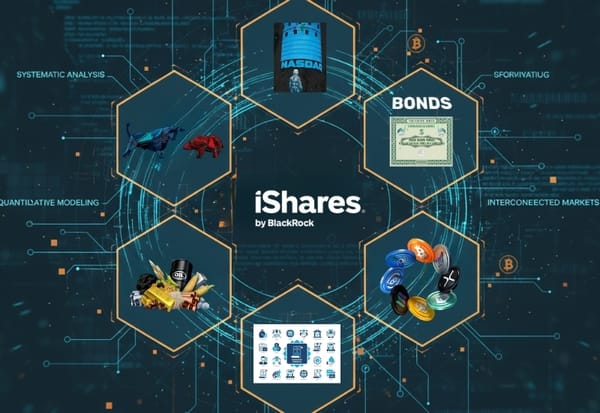Jake Claver's XRP Domino Theory: Mapping the Path to Financial Revolution
Jake Claver's XRP Domino Theory maps five interconnected financial dominoes that could trigger XRP's rise to $10,000. From Japan's digital yen development to Treasury market instability, discover why this systematic framework suggests we're witnessing the birth of a new global financial order.

A comprehensive analysis of the five-stage financial cascade that could transform XRP into the backbone of the global monetary system
In March 2025, Jake Claver, Managing Director of Digital Ascension Group and CEO of Syndicat Lee, revisited his influential XRP Domino Theory through a detailed social media breakdown. His provocative assertion: "Financial systems aren't just connected—they're deeply intertwined in ways most people don't see and can trigger massive chain reactions."
This isn't merely another crypto price prediction. Claver's framework presents a rational, interconnected analysis of how global financial instabilities could create the perfect storm for XRP's emergence as the world's premier bridge currency. His theory maps out five critical dominoes that, when they fall in sequence, could drive XRP to unprecedented price levels—potentially reaching $10,000 by 2027.
The Five Domino Framework: A Rational Look at Global Financial Vulnerability
Domino #1: Japan & The Digital Yen Revolution
The first domino centers on Japan's remarkable economic awakening after decades of stagnation. Japan's economy is waking up after decades of stagnation. Their stock market is climbing toward 1980s highs, and they're ahead of all G7 nations in developing a central bank digital currency.
Current Status: ✅ PARTIALLY TRIGGERED
Japan has made significant progress on CBDC development. The Bank of Japan launched its digital yen pilot program in April 2023, involving 64 private companies through the CBDC Forum. While no immediate launch plans exist, the infrastructure development continues advancing Japan's position as the G7 leader in CBDC readiness.
The critical implications: As the world's largest foreign holder of US Treasuries at $1.06 trillion, Japan's potential shift toward domestic digital currency infrastructure could trigger significant capital reallocation away from US debt markets.
Domino #2: US Treasury Market Instability
Claver's account highlights that this scenario unfolds when the Federal Reserve has raised interest rates and the yield curve is inverted, conditions that historically signal economic distress.
Current Status: ⚠️ CONDITIONS EMERGING
Recent market activity shows concerning Treasury dynamics. In 2025, Japan has already begun reducing its US Treasury holdings substantially, with a $119.3 billion reduction in a single quarter—the steepest drop since 2012. While Japanese officials have stated they won't sell purely for diplomatic reasons, market analysts note that private Japanese institutions like Nippon Life control these holdings, not the government.
Domino #3: Stablecoin Volatility Crisis
"DOMINO #3: STABLECOIN VOLATILITY. Stablecoins like Tether are the glue holding crypto markets together." Claver warns that Treasury market instability directly threatens stablecoin backing, as most major stablecoins rely heavily on US government debt reserves.
Current Status: 🟡 MONITORING STAGE
With Treasury yields experiencing volatility and bond vigilantes increasingly active, the foundation supporting stablecoin stability shows stress fractures. Claver references the Terra Luna collapse as precedent for how quickly confidence can evaporate.
Domino #4: Crypto Market Chaos
Bitcoin, now heavily integrated with traditional finance, faces significant risk if stablecoins experience turbulence. With spot Bitcoin ETFs gaining prominence and major financial institutions such as BlackRock and Fidelity having substantial exposure, any shock in crypto liquidity could trigger severe losses.
Current Status: 🟡 INSTITUTIONAL EXPOSURE BUILDING
The traditional finance integration Claver predicted has accelerated dramatically, with major asset managers now deeply exposed to crypto markets through ETF products and direct holdings.
Domino #5: Stock Market Selloffs
The final stage, "DOMINO #5: STOCK MARKET SELLOFFS," is the culmination of these financial disturbances. Claver argues that if large institutions suffer unexpected losses in crypto, they will be forced to liquidate stock positions rapidly, thereby intensifying market downturns.
Current Status: 🔴 AWAITING TRIGGER
This represents the cascading finale where institutional losses force broad asset liquidation, creating the liquidity crisis that Claver believes will drive demand for XRP's real-time settlement capabilities.
XRP as the Financial System's Lifeline
Claver's theory positions XRP not as a speculative asset, but as critical financial infrastructure. In this environment of heightened uncertainty and reduced central bank maneuverability, Claver contends that XRP stands to benefit significantly. He emphasizes that Ripple has positioned XRP as a bridge currency capable of executing fast and scalable cross-border transactions.
The foundation is already being laid. SBI Holdings in Japan is preparing to use XRP for settlements, while the DTCC has been testing blockchain integration through Project ION.
The Price Efficiency Hypothesis
Claver's $10,000 XRP target isn't based on speculation but on network efficiency requirements. Citing Ripple CTO David Schwartz's mathematical framework: moving $1 million requires 1 million XRP at $1 per token, but only 100,000 tokens at $10, or just one token at $1 million.
At its current $3 price and $186 billion market cap, it lacks the liquidity to support trillion-dollar transactions. But at $10,000 per coin, implying a notional $585 trillion in liquidity, XRP could theoretically handle such transfers with ease.
The BlackRock Connection: Strategic Alignment
Recent analysis suggests potential strategic alignment between Ripple and BlackRock, though not necessarily through formal partnership. Jake Claver, Managing Director of Digital Ascension Group and CEO of Syndicat Lee, recently spoke to the Paul Barron Network about what he describes as a "unique lockstep" between Ripple and BlackRock.
The theory suggests XRP could serve as a "liquidity buffer" during large-scale market disruptions, enabling institutions to rapidly rebalance capital across global markets.
Domino Theory Checklist: What's Happened and What's Next
✅ COMPLETED MILESTONES:
- Japan's CBDC pilot program launched (April 2023)
- Digital yen infrastructure development with 64 private companies
- Japan reducing US Treasury holdings ($119.3B quarterly reduction)
- Traditional finance crypto integration via ETFs
- DTCC blockchain testing through Project ION
- Rising Treasury market volatility
🟡 IN PROGRESS:
- Japanese digital yen final development phases
- Continued Treasury market stress testing
- Stablecoin regulatory scrutiny intensifying
- Institutional crypto exposure expanding
🔴 AWAITING TRIGGERS:
- Japanese digital yen official launch decision
- Major stablecoin stability crisis
- Significant crypto market liquidity shock
- Forced institutional liquidations
- XRP supply shock during global liquidity crisis
Timeline and Price Targets
Claver has provided multiple timeline scenarios:
- Conservative Target: $1,500-$2,000 by January 2026
- Ambitious Target: $10,000 within 24 months (by 2027)
Importantly, Claver emphasizes that XRP's major price movement will come from "a supply shock during a global liquidity crisis" rather than regulatory developments alone.
The Revolution Context: Beyond Price Speculation
This framework represents more than crypto market analysis—it's a blueprint for financial system evolution. Claver's theory suggests we're witnessing the transition from dollar-dominated global finance to a multipolar system where digital assets serve as neutral bridge currencies.
The precedent exists: during the 1933 Great Depression, the US government revalued gold to reduce debt burden. Claver's theory suggests XRP could serve a similar function in resolving modern liquidity crises, but on a global scale with near-instant settlement.
Critical Analysis and Skepticism
Not everyone embraces Claver's ambitious projections. Alex Caraco, former CEO of an Australian stock exchange, states: "It's sad to see buyers sold the story of $10,000 XRP happening tomorrow."
The theory requires massive systemic changes and assumes XRP's adoption as primary institutional liquidity infrastructure—outcomes that remain unproven despite compelling technical capabilities.
Conclusion: A Rational Framework for Financial Evolution
Whether one agrees with Claver's price targets or timeline, his Domino Theory provides a sophisticated framework for understanding global financial interconnectedness. The first dominoes are already falling—Japan's CBDC development and Treasury market dynamics are creating the conditions he identified.
The theory's power lies not in guaranteed outcomes, but in its systematic approach to analyzing how financial crises could accelerate the adoption of neutral, efficient settlement infrastructure like XRP. As traditional financial systems strain under geopolitical pressures and technological obsolescence, Claver's vision of XRP as the backbone of a new financial order becomes increasingly plausible.
The dominoes are aligned. The question isn't whether they'll fall, but when—and whether XRP will be ready to serve as the foundation for what comes next.
DISCLAIMER: This newsletter is for informational purposes only and does not constitute investment advice or a recommendation to buy, sell, or hold any securities. Investments in cryptocurrencies or other financial assets carry significant risks, including the potential for total loss, extreme volatility, and regulatory uncertainty. Past performance is not indicative of future results. Always consult a qualified financial professional and conduct thorough research before making any investment decisions.



